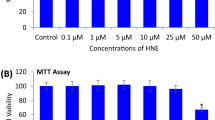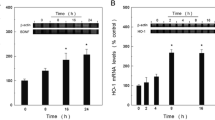Abstract
The objective of this study was to investigate the differential effects of various selenium (Se) compounds and Se-enriched broccoli extracts on cell proliferation and the possible mechanism responsible for the Se-induced growth inhibition. C6 rat glial cells were incubated with graded concentrations up to 1000 nM of selenite, selenate, selenomethionine (SeM), Se-methyl-selenocysteine (SeMCys), high-Se broccoli (H-SeB) extract or low-Se broccoli (L-SeB) extract for 24 and 48 h. MTT results indicated that all Se sources and levels examined inhibited C6 cell proliferation at 48 h. The results from cell cycle progression and apoptosis analysis indicated that SeM, SeMCys, H-SeB or L-SeB treatments at the concentration of 1000 nM reduced the cell population in G0/G1 phase, but induced G2/M phase arrest and increased apoptosis and secondary necrosis in C6 cells at 24 h. The populations of apoptotic cells and secondary necrotic cells were increased by all Se sources examined. The COMET assay indicated that there was no significant DNA single-strand break found for all Se treatments in C6 cells for 48 h. In addition, the Se-induced proliferation inhibition may involve a hydrogen peroxide (H2O2)-dependent mechanism with elevated cellular glutathione peroxidase (cGPX) activity. Both H-SeB and L-SeB inhibited C6 cell proliferation but H-SeB was less inhibitory than L-SeB. The proliferation inhibition by H-SeB in C6 cells is apparently related to the increased H2O2 with the elevated cGPX activity, but the inhibition by L-SeB was H2O2-independent without change in cGPX activity.
Similar content being viewed by others
References
MA Beilstein and PD Whanger, Deposition of dietary organic and inorganic selenium in rat erythrocyte proteins. J Nutr 16 (1986) 1701-1710
MM Bradford, A rapid and sensitive method for the quantitation of microgram quantities of protein utilizing the principle of protein–dye binding. Anal Biochem 72 (1976) 248-254
X-Y Cai, E Block, PC Uden, X Zhang, BD Quimby and JJ Sullivan, Allium chemistry: identification of selenoamino acids in ordinary and selenium enriched garlic, onions, and broccoli using gas chromatography with atomic emission detection. J Agric Food Chem 43 (1995) 1754-1760
C Charron, D Kopsell, W Randle and C Sams, Sodium selenate fertilisation increases selenium accumulation and decreased glucosinolate concentration in rapid-cycling Brassica oleracea. J Sci Food Agric 81 (2001) 962-966
LC Clark, GF Combs Jr and BW Turnbull, Effects of selenium supplementation for cancer prevention in patients with carcinoma of the skin. A randomized controlled trial. Nutritional Prevention of Cancer Study Group. J Am Med Assoc 276 (1996) 1957-1963
LC Clark, B Dalkin and A Krongrad, Decreased incidence of prostate cancer with selenium supplementation: results of a double-blind cancer prevention trial. Brit J Urol 81 (1998) 730-734
M Cummings, T Siitonen, K Higginbottom, AC Newland and PD Allen, p53-mediated downregulation of chk1 abrogates the DNA damage-induced G2M checkpoint in K562 cells, resulting in increased apoptosis. Br J Haematol 116 (2002) 421-428
Y Feng, JW Finley, CD Davis, WK Becker, AJ Fretland and DW Hein, Dietary selenium reduces the formation of aberrant crypts in rats administered 3, 2′-dimethyl-4-aminobiphenyl in inhibiting colon carcinogenesis. Toxicol Appl Pharmacol 157 (1999) 36-42
JW Finley and CD Davis, Selenium (Se) from high-selenium broccoli is utilized differently than selenite, selenate and selenomethionine, but is more effective in inhibiting colon carcinogenesis. Biofactors 14 (2001) 191-196
JW Finley, CD Davis and Y Feng, Selenium from high selenium broccoli protects rats from colon cancer. J Nutr 130 (2000) 2384-2389
JW Finley, C Ip, DJ Lisk, CD Davis, K Hintze and PD Whanger, Cancer-protective properties of high-selenium broccoli. J Agric Food Chem 49 (2001) 2679-2685
JW Finley, A Sigrid-Keck, R Robbins and KJ Hintze, Selenium enrichment of broccoli: interactions between selenium and secondary plant compounds. J Nutr 135 (2005) 1236-1238
M Gangloff, R Glahn, D Miller and D Campen van, Assessment of iron availability using combined in vitro digestion and Caco-2 cell culture. Nutr Res 16 (1996) 479-487
VN Gladyshev and DL Hatfield, Selenocysteine-containing proteins in mammals. J Biomed Sci 6 (1999) 151-160
K Huang, H Liu, Z Chen and H Xu, Role of selenium in cytoprotection against cholesterol oxide-induced vascular damage in rats. Atherosclerosis 162 (2002) 137-144
C Ip, Lessons from basic research in selenium and cancer prevention. J Nutr 128 (1998) 1845-1854
C Ip, DJ Lisk and GS Stoewsand, Mammary cancer prevention by regular and selenium-enriched garlic. Nutr Cancer 17 (1992) 279-284
C Ip, HJ Thompson, Z Zhu and HE Ganther, In vitro and in vivo studies of methylseleninic acid: evidence that a monomethylated selenium metabolite is critical for cancer chemoprevention. Cancer Res 60 (2000) 2882-2886
MH Lewin, JR Arthur and RA Riemersma, Selenium supplementation acting through the induction of thioredoxin reductase and glutathione peroxidase protects the human endothelial cell line Eahy926 from damage by lipid hydroperoxides. Biochim Biophys Acta 1593 (2002) 85-92
T Mosmann, Rapid colorimetric assay for cellular growth and survival: application to proliferation and cytotoxicity assays. J Immunol Meth 65 (1983) 55-63
DE Paglia and WN Valentine, Studies on the quantitative and qualitative characterization of erythrocyte glutathione peroxidase. J Lab Clin Med 70 (1967) 158-169
G Parnaud, P Li and G Cassar, Mechanism of sulforaphane-induced cell cycle arrest and apoptosis in human colon cancer cells. Nutr Cancer 48 (2004) 198-206
HS Park, SH Huh and Y Kim, Selenite negatively regulate caspase-3 through a redox mechanism. J Biol Chem 275 (2000) 8487-8491
TS Rafferty, MH Green and JE Lowe, Effects of selenium compounds on induction of DNA damage by broadband ultraviolet radiation in human keratinocytes. Br J Dermatol 148 (2003) 1001-1009
C Redman, JA Scott and AT Baines, Inhibitory effect of selenomethionine on the growth of three selected human tumor cell lines. Cancer Lett 125 (1998) 103-110
RJ Robbins, AS Keck, G Banuelos and JW Finley, Cultivation conditions and selenium fertilization alter the phenolic profile, glucosinolate, and sulforaphane content of broccoli. J Med Food 8 (2005) 204-214
YR Seo, C Sweeney and ML Smith, Selenomethionine induction of DNA repair response in human fibroblasts. Oncogene 21 (2002) 3663-3669
CL Shen, W Song and BC Pence, Interactions of selenium compounds with other antioxidants in DNA damage and apoptosis in human normal keratinocytes. Cancer Epidemiol Biomarkers Prev 10 (2001) 385-390
NP Singh, MT McCoy, RR Tice and EL Schneider, A simple technique for quantitation of low levels of DNA damage in individual cells. Exp Cell Res 175 (1988) 184-191
R Sinha and K El-Bayoumy, Apoptosis is a critical cellular event in cancer chemoprevention and chemotherapy by selenium compounds. Curr Cancer Drug Targets 4 (2004) 13-28
Steel RGD, Torrie LH. 1980 In: Steel RGD, Torrie LH (eds) Principles and Procedures of Statistics. New York, NY: McGraw-Hill, USA
R Tang and K Huang, Inhibiting effect of selenium on oxysterols-induced apoptosis of rat vascular smooth muscle cells. J Inorg Biochem 98 (2004) 1678-1685
H Tapiero, DM Townsend and KD Tew, The antioxidant role of selenium and seleno-compounds. Biomed Pharmacother 57 (2003) 134-144
N Terry, AM Zayed, MP deSouza and AS Tarun, Selenium in higher plants. Annu Rev Plant Physiol 51 (2000) 401-420
V Venkateswaran, LH Klotz and NE Fleshner, Selenium modulation of cell proliferation and cell cycle biomarkers in human prostate carcinoma cell lines. Cancer Res 62 (2002) 2540-2545
DJ Water, S Shen and DM Cooley, Effects of dietary selenium supplementation on DNA damage and apoptosis in canine prostate. J Natl Cancer Inst 95 (2003) 237-241
PD Whanger, Selenocompounds in plants and animals and their biological significance. J Am College Nutr 21 (2002) 223-228
PD Whanger, Selenium and its relationship to cancer: an update. Brit J Nutr 91 (2004) 11-28
PD Whanger, C Ip, CE Polan, PC Uden and G Welbaum, Tumorigenesis, metabolism, speciation, bioavailability, and tissue deposition of selenium in selenium-enriched ramps (Allium tricoccum). J Agric Food Chem 48 (2000) 5723-5730
JY Yeh, LC Cheng, YC Liang and BR Ou, Modulation of the arsenic effects on cytotoxicity, viability and cell cycle in porcine endothelial cells by selenium. Endothelium 10 (2003) 127-139
JY Yeh, LC Cheng, BR Ou, PD Whanger and LW Chang, Differential influences of various arsenic compounds on glutathione redox status and antioxidative enzymes in porcine endothelial cells. Cell Mol Life Sci 59 (2002) 1972-1982
JK Yeo, SD Cha and CH Cho, Se-methylselemocysteine induces apoptosis through Caspase activation and Bax cleavage mediated by calpain in SKOV-3 ovarian cancer cells. Cancer Lett 182 (2002) 83-92
W Zhong and TD Oberley, Redox-mediated effects of selenium on apoptosis and cell cycle in the LNCaP human prostate cancer cell line. Cancer Res 61 (2001) 7071-7078
M Zhou, Z Diwu, N Panchuk-Voloshina and RP Haugland, A stable nonfluorescent derivative of resorufin for the fluorometric determination of trace hydrogen peroxide: applications in detecting the activity of phagocyte NADPH oxidase and other oxidases. Anal Biochem 253 (1997) 162-168
N Zhou, H Xiao, T-K Li, A Nur-E-Kamal and LF Liu, DNA damage-mediated apoptosis induced by selenium compounds. J Biol Chem 278 (2003) 29532-29537
Z Zhu, M Kimura and Y Itokawa, Apoptosis induced by selenium in human glioma cell lines. Biol Trace Elem Res 54 (1996) 123-134
Author information
Authors and Affiliations
Corresponding author
Rights and permissions
About this article
Cite this article
Yeh, JY., Ou, BR., Liang, YC. et al. Mechanism for proliferation inhibition by various selenium compounds and selenium-enriched broccoli extract in rat glial cells. Biometals 19, 611–621 (2006). https://doi.org/10.1007/s10534-006-0007-y
Received:
Accepted:
Published:
Issue Date:
DOI: https://doi.org/10.1007/s10534-006-0007-y




